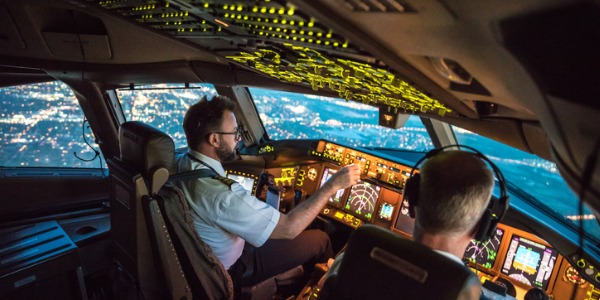What is a Commercial Pilot?
Do you love to fly? Have you always dreamt of being a pilot?
Airline pilots usually start their careers as commercial pilots. Any pilot that is paid to fly must have at minimum a commercial pilot's license.
Commercial pilots can fly aircraft for charter flights, rescue operations, firefighting, aerial photography, and crop dusting.
What does a Commercial Pilot do?

Commercial pilots typically do the following:
- Follow a checklist of preflight checks on engines, hydraulics, and other systems
- Ensure that all cargo has been loaded and that the aircraft weight is properly balanced
- Check fuel, weather conditions, and flight schedules
- Contact the control tower for takeoff and arrival instructions
- Start engines, operate controls, and steer aircraft along planned routes
- Monitor engines, fuel consumption, and other aircraft systems during flight
- Navigate the aircraft, using cockpit instruments
- Ensure a smooth takeoff and landing
For all but small aircraft, two pilots usually make up the cockpit crew. Generally, the most experienced pilot - the captain - is in command and supervises all other crew members. The copilot, often called the first officer, shares flight duties with the captain. These duties include communicating with air traffic controllers, monitoring instruments, and steering the plane.
Before departure, commercial pilots plan their flights carefully, checking various systems on the aircraft and making sure that baggage and cargo have been loaded correctly. They also confer with air traffic controllers to learn about weather conditions and to confirm the flight route.
Takeoffs and landings are the most difficult parts of the flight and require close coordination between the pilot and copilot. Once in the air, the captain and first officer usually alternate flying each leg of the flight. After landing, pilots must fill out records that document their flight and the maintenance status of the plane.
Commercial pilots employed by charter companies usually have many more non-flight duties. For example, they may schedule flights, arrange for maintenance of the plane, and load luggage to ensure a balanced weight.
Pilots who fly helicopters must constantly look out for trees, bridges, power lines, transmission towers, and other dangerous obstacles.
Regardless of the type of aircraft, all pilots must monitor warning devices that detect sudden shifts in wind patterns. Because warning signals can appear with no notice, pilots must be able to respond quickly to any impending danger. They work closely with air traffic controllers and flight dispatchers. As a result, they need to be able to coordinate actions on the basis of the feedback they receive.
What is the workplace of a Commercial Pilot like?
Commercial pilots work for airline companies, the federal government, express delivery companies, charter companies, private businesses, flight schools, and hospitals.
Depending on who they work for, they could spend a considerable amount of time away from home, sometimes overnight or longer.
Frequently Asked Questions
Should I become a Commercial Pilot?
Do you love flying? The path to becoming a commercial pilot is not an easy journey, so it's crucial that you truly love flying if you are thinking of this as a career.
One thing to seriously consider is that the training and certification can be very costly. Getting your private pilot license (which is the first step) can run approximately $10,000. To earn this private pilot license you will need 40 hours of flight time as well as roughly triple that number in ground training and book work. After earning this license, you are able to fly in sunny weather only.
But what if there are clouds? In order to be able to fly in anything other than picture perfect weather, you will need to pass your instrument training. This entails more studying, more practicing, and approximately $8000. Once you have passed your instrument training, you can fly a plane in mixed weather and through clouds. However, at this point you can only fly for yourself and everything you have done so far only applies to single-engine planes.
Getting your commercial pilot license means getting commercial certifications for multi-engine planes. This means more studying, and 250 flight hours.
In total, pilot training costs approximately $65,000 when starting with a private pilot certificate, or around $80,000 from ground zero. Both prices include the flight training, instrument training, and the certification necessary to become a commercial pilot with flight instructor certificates.
After getting a commercial pilot license, you are fully qualified. However, with no work experience, finding a job will prove to be quite difficult. Most people in this position choose to become flight instructors in order to gain enough experience to become commercial pilots.
Pilots must also pass a physical health exam every year to be able to fly. This is an important factor to consider, as something entirely out of their control can mean they will no longer be fit to fly.
Commercial Pilots are also known as:
Commercial Airline Pilot
Commercial Aircraft Pilot